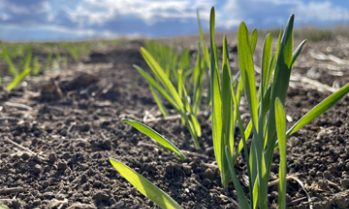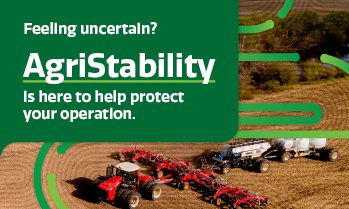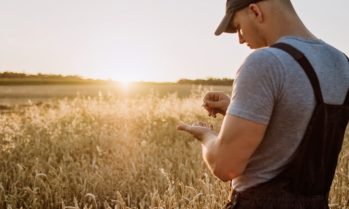Is it time to participate in AgriStability?
Article written by SCIC
Variation of this article is available in the 2024 Yield Saskatchewan publication (presented by The Western Producer) and the Spring 2024 issue of Agriview
The agriculture industry is unpredictable. While producers cannot control the weather, market fluctuations or rising input costs, you can take steps to manage that risk with AgriStability.
AgriStability is a cost-effective business risk management program designed to help farm operations facing large margin declines. At $4.50 for every $1,000 covered Contribution Reference Margin multiplied by 70 per cent the annual AgriStability fee is $3.15 for every $1,000 of margin covered. For Saskatchewan producers, the average cost to participate is $0.69 per acre for grain operations, or $1.19 per head for livestock operations.
Coverage is personalized by using each farm’s historical financial information, current income, expenses and accrual adjustments directly related to the farm’s production. AgriStability uses margins to evaluate the financial performance of the operation for the current year compared to the historical financial performance. The current year’s financial profile is called the program year margin and the historical information builds the reference margin. The reference margin is determined by excluding the highest and lowest margins in the previous five years and averaging the remaining three years. Accrual adjustments are included each year to measure changes in a farm’s accounts receivable, accounts payable, purchased inputs and commodity inventories.
An AgriStability payment is triggered if the program year margin falls below 70 per cent of the reference margin. In the last six years, AgriStability provided over $500 million in benefits to Saskatchewan producers.
Recent Program Enhancements
Starting in the 2023 program year, the AgriStability compensation rate increased from 70 per cent to 80 per cent; therefore, when the program year margin declines by more than 30 per cent of the reference margin, AgriStability provides a benefit payment of 80 cents for every dollar of decline below the trigger point. In other words, producers with an eligible margin decline will receive larger AgriStability benefits.
Other recent changes include the removal of the Reference Margin Limit (RML) and the removal of private insurance indemnities from allowable income. By removing the RML, farming operations with lower allowable expenses saw increased coverage and accessed larger benefits. And, with changing private insurance indemnities (such as benefits from private hail insurance, Livestock Price Insurance (LPI), or Global Ag Risk Solutions (GARS) to be non-allowable income, producers have more flexibility to access these additional producer-paid risk management options and their AgriStability benefits are not impacted.
Upcoming Changes
Starting in the 2024 program year, the deadline to submit AgriStability program forms, without penalty, is changing to June 30, 2025. (Current AgriStability participants still have until September 30, 2024, to submit their 2023 program forms). For many years, producers expressed frustration with the current September 30 deadline as it occurs during the busy harvest season. Since AgriStability forms require tax information, moving up the deadline to June 30 allows producers to align their AgriStability form submissions with their tax filing. In addition, SCIC can work on producers’ AgriStability files earlier in the year; applications can be processed quicker and payments issued sooner. This enables AgriStability to respond sooner, with timely payments to producers who experienced disaster and need that additional financial support.
While these changes help provide greater stability for producers during times of uncertainty, the federal and provincial governments continue working alongside SCIC and industry groups to make AgriStability more timely, predictable and easy to understand.
AgriStability Works For Livestock Producers
Recent years were particularly challenging for livestock producers due to dry conditions and lack of feed supply across many regions of the province. There are features of the AgriStability Program which can help support many of these financial challenges.
- AgriStability includes additional feed expenses in a producer’s benefit calculation. Whether buying pellets, hay or additional feed grain for livestock, purchasing feed is an allowable expense.
- In situations where producers are buying and then baling standing hay, greenfeed or silage from another producer, that expense is also allowable.
- AgriStability provides flexibility for producers needing to access additional pasture for their livestock. To be an allowable expense, accessing additional pasture must be conducted through a “custom grazing” arrangement. Land rent or pasture rent is not allowable.
- If producers reduced their herd size due to a lack of feed as a result of the drought, AgriStability can respond to that change in herd size. The Program will capture the change in the farm’s productive capacity as a result of the disaster.
- AgriStability can also help cover some of the cost of hauling water to livestock. The additional expense a producer incurs to acquire and transport water to their livestock is an allowable expense, including fuel and fees to purchase the water.
It's Easy To Enrol
Enrolling in AgriStability is as simple as calling the SCIC AgriStability Call Centre at 1-866-270-8450 and requesting a new participant package. To participate in the 2024 program year, the enrolment request must be made by April 30, 2024.









